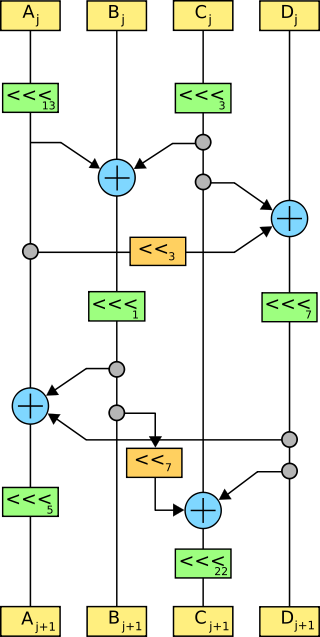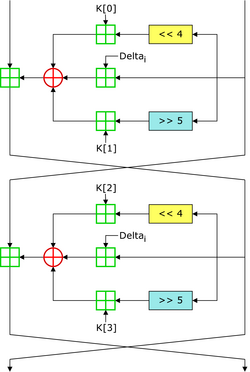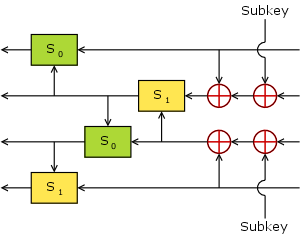
The Data Encryption Standard is a symmetric-key algorithm for the encryption of digital data. Although its short key length of 56 bits makes it too insecure for modern applications, it has been highly influential in the advancement of cryptography.
Differential cryptanalysis is a general form of cryptanalysis applicable primarily to block ciphers, but also to stream ciphers and cryptographic hash functions. In the broadest sense, it is the study of how differences in information input can affect the resultant difference at the output. In the case of a block cipher, it refers to a set of techniques for tracing differences through the network of transformation, discovering where the cipher exhibits non-random behavior, and exploiting such properties to recover the secret key.

Eli Biham is an Israeli cryptographer and cryptanalyst who is a professor at the Technion - Israel Institute of Technology Computer Science department. From 2008 to 2013, Biham was the dean of the Technion Computer Science department, after serving for two years as chief of CS graduate school. Biham invented (publicly) differential cryptanalysis, for which he received his Ph.D., while working under Adi Shamir. It had been invented before by a team at IBM during their Data Encryption Standard work; the National Security Agency told IBM to keep the discovery secret.

Serpent is a symmetric key block cipher that was a finalist in the Advanced Encryption Standard (AES) contest, in which it ranked second to Rijndael. Serpent was designed by Ross Anderson, Eli Biham, and Lars Knudsen.

A cryptographic hash function (CHF) is a hash algorithm that has special properties desirable for a cryptographic application:
In cryptography, Tiger is a cryptographic hash function designed by Ross Anderson and Eli Biham in 1995 for efficiency on 64-bit platforms. The size of a Tiger hash value is 192 bits. Truncated versions can be used for compatibility with protocols assuming a particular hash size. Unlike the SHA-2 family, no distinguishing initialization values are defined; they are simply prefixes of the full Tiger/192 hash value.

In cryptography, the Tiny Encryption Algorithm (TEA) is a block cipher notable for its simplicity of description and implementation, typically a few lines of code. It was designed by David Wheeler and Roger Needham of the Cambridge Computer Laboratory; it was first presented at the Fast Software Encryption workshop in Leuven in 1994, and first published in the proceedings of that workshop.

In cryptography, FEAL is a block cipher proposed as an alternative to the Data Encryption Standard (DES), and designed to be much faster in software. The Feistel based algorithm was first published in 1987 by Akihiro Shimizu and Shoji Miyaguchi from NTT. The cipher is susceptible to various forms of cryptanalysis, and has acted as a catalyst in the discovery of differential and linear cryptanalysis.
In cryptography, Khufu and Khafre are two block ciphers designed by Ralph Merkle in 1989 while working at Xerox's Palo Alto Research Center. Along with Snefru, a cryptographic hash function, the ciphers were named after the Egyptian Pharaohs Khufu, Khafre and Sneferu.
In cryptography, N-hash is a cryptographic hash function based on the FEAL round function, and is now considered insecure. It was proposed in 1990 in an article by Miyaguchi, Ohta, and Iwata; weaknesses were published the following year.
In cryptography, REDOC II and REDOC III are block ciphers designed by cryptographer Michael Wood for Cryptech Inc and are optimised for use in software. Both REDOC ciphers are patented.
Bart Preneel is a Belgian cryptographer and cryptanalyst. He is a professor at Katholieke Universiteit Leuven, in the COSIC group.

In cryptography, the boomerang attack is a method for the cryptanalysis of block ciphers based on differential cryptanalysis. The attack was published in 1999 by David Wagner, who used it to break the COCONUT98 cipher.
Introduced by Martin Hellman and Susan K. Langford in 1994, the differential-linear attack is a mix of both linear cryptanalysis and differential cryptanalysis.
In cryptography, Nimbus is a block cipher invented by Alexis Machado in 2000. It was submitted to the NESSIE project, but was not selected.
In cryptography, Q is a block cipher invented by Leslie McBride. It was submitted to the NESSIE project, but was not selected.
In cryptography, COCONUT98 is a block cipher designed by Serge Vaudenay in 1998. It was one of the first concrete applications of Vaudenay's decorrelation theory, designed to be provably secure against differential cryptanalysis, linear cryptanalysis, and even certain types of undiscovered cryptanalytic attacks.
The following outline is provided as an overview of and topical guide to cryptography:
This article summarizes publicly known attacks against block ciphers and stream ciphers. Note that there are perhaps attacks that are not publicly known, and not all entries may be up to date.

Orr Dunkelman is an Israeli cryptographer and cryptanalyst, currently a professor at the University of Haifa Computer Science department. Dunkelman is a co-director of the Center for Cyber Law & Privacy at the University of Haifa and a co-founder of Privacy Israel, an Israeli NGO for promoting privacy in Israel.








